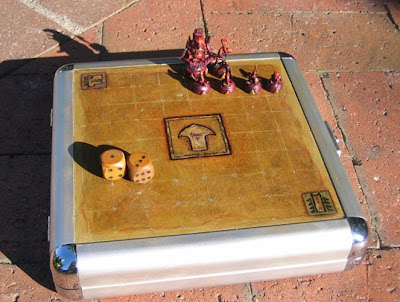contents:
2 six sided dice
2 teams with 8 pieces each - see images
-the # of dots on the piece = #of dice pips needed to capture it.
6 scoring tokens (3 per team)
game board with 4 objective squares in the center and a reserect square in the corners of each deplyment zone.
Setup:
both players set up their pieces as shown in the figure below.
decide which player will go first.
Goal:
The players are competing to be the first to score three points. Points are scored each time a player kills the oponents priest or holds the objective
undesputed till for a full turn sequence.
Turn Sequence:
The active player will roll both die to begin his turn. The results of the rolls can be used to move, attack, or reserect destroyed pieces. The player must use all the pips rolled on one die to active a single piece before using the pips from the second roll to acive a different piece.The results of the two rolls can never be combined. Once the first player has used all the pips on both his dice then his turn end s and his opponents turn begins.
Moving - Move your piece the number of pips on the die. You can only move less spaces than pips on the die if you use the remaining pips to attack with. Pieces move orthogonaly. Pieces are not allowed to move diagonaly or to move thorugh other pieces.
Attacking - To attack you must be adjecent to the opponents piece you plan to attack and have the same number of pips left as the strength of the unitto be attacked.
Doubles - If doubles are rolled then you may use both dice to activat the same piece. Each activation is still handled separately so you cannot combine the results of the two rolls in order to capture a strong enemy piece.
Reserection - As long as the player hasn't rolled doubles they have the option to bing in destroyed pieces. The player may choose to sacrifice their highest dice result in order to bring back a piece that was destroyed by thier opponents. In order for this to happen they must give up their highest dice result and the reserection square must be empty.
Scoring:
Each time a player scores a point he marks this by taking a scoring token and placing it between himself and his depoyment zone to mark his score. His opponent then takes a marker and places it in the corner of his reserection square to mark that he has gained a free reroll. A player may only have one reroll token at a time if they do not use it before thier opponent scores again then the new reroll token will be lost. A reroll token may be used to reroll one die roll.
Take and Hold - When a player end his turn with one or more of his pieces in the objective squares while his opponent doesn't have any pieces in objective squares place a scoring marker in the center of the objective. This maks that the player has taken the objective. If they can hold the objective the remainder of the turn sequence then they have scored a point and get the marker. If the opponent is able to move a piece into an objective square or destroy all your scoring units the marker is removed.
Kill - The other way to score is to destroyh the opponents priest. Destroying the a priest is difficult because the priests' defensive value is 6. This means you will need to already be next to the enemies priest and roll a 6 in order to destroy it.
Tactics and Balance:
The opponent of the scoring player is given a reroll token in order to give them a better chance to make a comback
Moving one of your pieces onto the opponents reserection square is a good tactic to shift the games momentum in your favor. Either you will be able to outnumber him in the long run because he cant bring in reserects or he hill have to turn his attention to freeing up that square instead.




